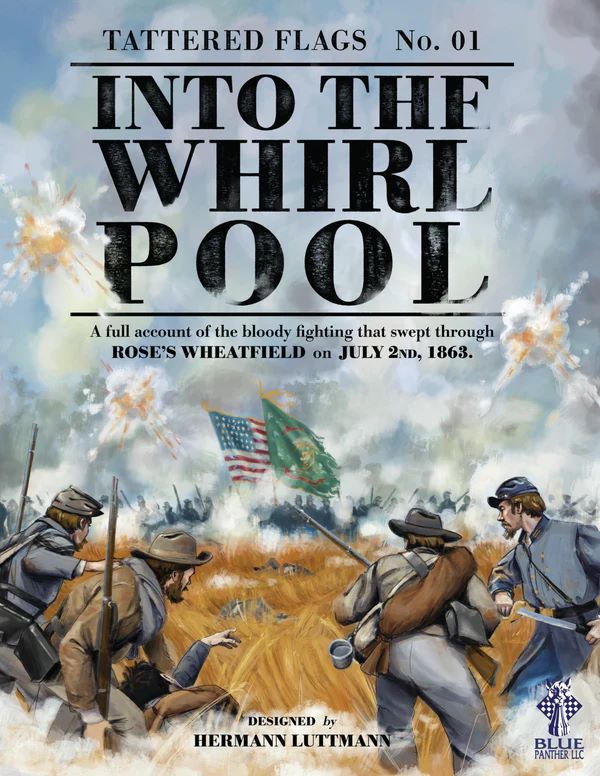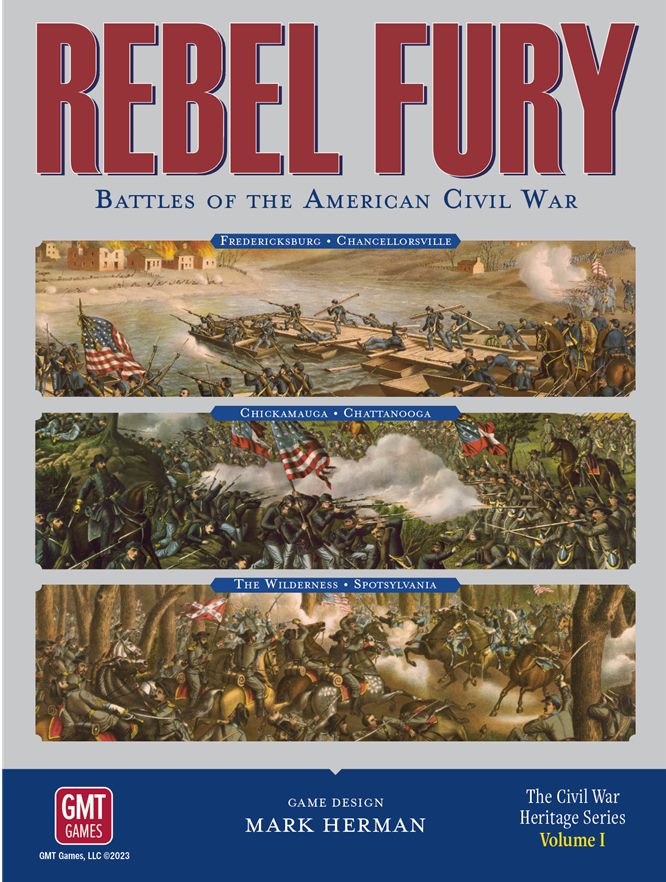Continuing our series on the Charles S Roberts awards winners and nominees for 2024, we’re looking at the U.S. Civil War category. From a war gaming perspective, as you’ll see in the list below, the Civil War offers such a variety of battles, terrain, and military technology, that the opportunities for fresh ideas at every level of rules complexity are vast. Whether you’re new to war gaming or want to dive into a long-running series, you’ll find excellent games below.
Civil Brigade at Gettysburg
A fresh entry in Worthington Publishing’s Old School Wargames Civil Brigade series (a mouthful, there), Gettysburg 1863 strives for and hits a balance between realism and rules grit. We’re talking a hex-and-counter, brigade-level experience with a slim 12-page rule book that can be used to cover every game in this series, a unique feature of war gaming that remains a huge draw. Anyway, what you’re getting here is Gettysburg done up in style, with a big mounted map, large 3/4 inch counters, and enough meat on the bone for the full battle to go 6-10 hours (smaller scenarios aim for 1-3, giving you plenty of options).
feature of war gaming that remains a huge draw. Anyway, what you’re getting here is Gettysburg done up in style, with a big mounted map, large 3/4 inch counters, and enough meat on the bone for the full battle to go 6-10 hours (smaller scenarios aim for 1-3, giving you plenty of options).
There are so many Gettysburg games out there that, even in a Civil War category, recommending another is a tall order. Yet, get this one to your table and you’ll see why – frankly, it’s the ease of the thing. Smooth gameplay that models company movement, morale, artillery, and elevation without bogging play down with a million steps. There are plenty of simulation options out there, but if you want a game that actually gets to the table, that will let you pull off cavalry charges and desperate strikes without thumbing through a tome, Gettysburg 1863 and its accompanying series is one to try. I’d add, too, that the lack of hidden information and cards makes this an easy both-sides solo venture.
Shiloh meets Blind Swords
Revolution Games’ Blind Swords series gets its 11th volume in Shiloh, The First Day, stuffing three counter sheets and several decent-sized maps into a ziploc (or box, if you prefer). You likely already know if you enjoy Blind Swords, which leverages chit pulls and events without guaranteeing that every unit will activate in a  round. It’s a dynamic mechanic that can see a single unit get several actions before some get any, leading to narrative highlights, like incursions or full retreats from dire traps. It’s also an excellent system for solo play thanks to chips driving the action – no hidden information, no having to ‘choose’ for each side.
round. It’s a dynamic mechanic that can see a single unit get several actions before some get any, leading to narrative highlights, like incursions or full retreats from dire traps. It’s also an excellent system for solo play thanks to chips driving the action – no hidden information, no having to ‘choose’ for each side.
Shiloh brings seven scenarios to the table, most of them designed (thankfully) to walk you through this game’s unique rules for terrain and other tidbits necessary to capture Shiloh’s traits. The smaller shots go a long way towards welcoming you to the full campaign, sticking with Blind Swords’ reputation for playability. Play up the ladder and you’ll find the rules, which strike a middle-weight balance, easy to handle by the time you’re throwing all the counters on the table. All told, for Blind Swords veterans, this is an easy recommendation. If you’ve never tried this system before, however, you might start with Kernstown or The Day Was Ours, as both offer approachable introductions with fewer special rules. Either way, you’re in for a war gaming treat with this series.
Taking a Tattered Page from Miniatures War Gaming
Blue Panther’s Tattered Flags: Into the Whirlpool melds a hex-and-counter experience with miniature wargaming to deliver a unique portrayal of Gettysburg (a portion of the battle, anyway). With a map overlaid with directional icons, Tattered Flags puts an emphasis on facing and motion, creating a more dynamic battle and feel than your average bushel of counters on a paper map. As you’d expect, this is a tactical level game, where firing range, line of sight, terrain, and individual glory all have a chance to shine.
of the battle, anyway). With a map overlaid with directional icons, Tattered Flags puts an emphasis on facing and motion, creating a more dynamic battle and feel than your average bushel of counters on a paper map. As you’d expect, this is a tactical level game, where firing range, line of sight, terrain, and individual glory all have a chance to shine.
Designed by Hermann Luttmann (who created the Blind Swords system used in Shiloh, above), Tattered Flags immerses its rules with the gameplay, generally enabling and going along with what you’d like to do. It’s not dead simple, but it is sensible, and newer war gamers, particularly those crossing over from miniatures gaming, will find it an easy pick-up. At the same time, for a hex-and-counter grognard, Tattered Flags might be the bridge to a whole new world of miniatures war gaming (the leap from Longstreet to Space Marines might be easier than you think).
Vicksburg Made Fresh
A new entry in Multi-Man Publishing’s Great Campaigns of the American Civil War series (so many long series names in war gaming), Thunder on the Mississippi gives you Grant’s Vicksburg venture with 11 scenarios and a giant, 70 turn campaign. You’re getting great production quality here, with detailed paper maps and counters by the hundred. Rules hit the medium range, though you’ll find a fair amount of scenario-specific exceptions meant to up the simulation factor and account for the varied situations.
But that’s what you’re buying into with Thunder – we’re talking rivers, wild forests, sieges and ambushes. You’ll rarely find a swath of counters arrayed in opposing lines, chucking dice to see who breaks through. Instead it’s a writhing war, with desperate Confederate lunges and Union gambits. Brigades handled without care might find themselves trapped beyond command range, while random events could add wrinkles to an ironclad assault (these, though, are easily ignored if preferred). No cards or hidden information makes Thunder a solid solo target too, though it’s not a small game, so make sure you have the table space to give this one the room it deserves.
Mark Herman Delivers a Gateway Great
It’s been said that the greatest game is the one that gets played. For war gamers, where titles regularly shoot past ten, twenty, or even thirty hours for a single game (albeit these are the grand campaigns), a title suffused with strategy and action that delivers, start to finish, quality in two or three hours stands out. Rebel Fury, the winner in the Civil War category, stands tall for that reason (among others). Like its name, Fury is fast, its rules are clean and easy to grasp, and it’s packed with  scenarios worth playing over and over. Which you will.
scenarios worth playing over and over. Which you will.
Speed infuses Rebel Fury in other ways too – units have two different modes, essentially: combat and movement. You can zip across the map, activating the same unit multiple times, until it winds up entering an enemy’s zone of control. Then, it flips to its fighting stance, ready to draw blood with combat tables partial to mass attacks. The trick here is that while your unit might have to ready up when it nears the enemy, that enemy isn’t under the same constraints. They can dash away, at least until they run headlong into one of your pieces. What this creates is a highly active board, with each player trying to snare advantageous terrain or trap each other into nets. It’s one of the most engaging, mobile hex-and-counter experiences around.
Combat runs as expected, with tables and modifiers setting up die rolls to deliver damage. Much is abstracted here, keeping things moving. Those wanting a detailed simulation should check out the other games on this list. Fury is interested in the bigger view, the divisions on the battlefield and how the war is getting won, not so much the accuracy of a particular artillery barrage.
You’ll get six scenarios in the box and they climb in complexity and possibility, as in most good war games. Fury’s mobility drives divergence, making different approaches viable every time you play. Moreover, Fury is the start of a new system, one with future volumes planned, including full-on campaigns (so you can create that thirty hour experience should you choose). For those interested in the Civil War, Rebel Fury serves as a great gateway experience, an exciting introduction to hex-and-counter war gaming for just about any player.
